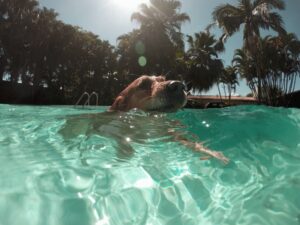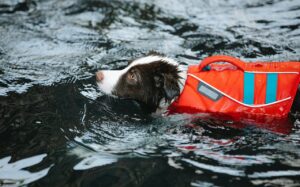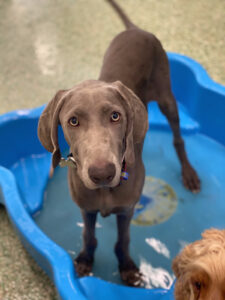With Summer in full force and many people still on holiday, there’s no better time to teach your dog to swim. Swimming can be an extremely beneficial activity for dogs of all ages, breeds, and sizes. Not only is it a great form of exercise, but it can also help dogs develop important skills like balance, coordination, and strength.
Teaching your dog to swim can be an incredibly rewarding experience, as it can help them build a strong bond with you while providing them with many other health benefits. With some patience and dedication, you and your dog can enjoy the many rewards that come with swimming.
What are the benefits of teaching your dog to swim?
Swimming is one of the best ways to exercise your dog without putting too much strain on their joints. It helps them to build muscle and burn calories and is a great way to cool off on a hot summer’s day. On top of that, swimming can help improve your dog’s overall health, reduce stress and anxiety, and increase their longevity.
Swimming can also help boost your dog’s self-confidence, as it can be a very new and exciting experience for them. It’s a great way for you and your pup to spend time together during the hot summer months, and it can also be an effective training tool for teaching them other new skills.
Safety considerations for swimming with your dog
As with any new activity, there are certain safety considerations that you’ll want to keep in mind before getting your dog into the water. Dogs can be anxious or nervous about getting into the water for the first time and it may take them some time to work up the courage to get into the water, so be prepared to be patient and take things slowly.
Be mindful that not all dogs are natural swimmers and there are certain breeds that cannot swim at all. Dogs with large chests and small legs such as Bulldogs, or with short legs like Dachshunds, aren’t designed for swimming and may not stay afloat. If these breeds are around a swimming pool or any other body of water where there’s potential for them to venture into deeper water, it’s important to make sure they are always supervised and are wearing a life vest.
around a swimming pool or any other body of water where there’s potential for them to venture into deeper water, it’s important to make sure they are always supervised and are wearing a life vest.
When swimming in public bodies of water with your dog, such as creeks, lakes or streams, there is a risk of your dog picking up an infection from drinking contaminated water, such as Giardia which can cause severe gastrointestinal disease. Read more about Giardia in dogs here.
Drinking from the ocean can also be dangerous for dogs as the salt water can cause diarrhea and vomiting, which can lead to dehydration. Call your dog out of the ocean if you notice them starting to drink the water, and give them some fresh water instead.
While swimming can be a great low-impact exercise for senior dogs, it can be strenuous for older dogs and they may tire easily, so be sure to watch for signs of overexertion.
How to introduce your dog to the water
For many dogs, their first experience with water can be a bit scary as it can be unfamiliar and cold, so it’s important to show patience as you introduce them to the water. Start by placing them in shallow water, such as a shallow pool or bathtub, and slowly encourage them to move forward. Keep the water at chest level or lower in the beginning. This will allow them to become comfortable with the water, and it can help minimise the risk of them going under or struggling. You can also incorporate treats or toys into their first swimming experience to make it more fun for them.
It might take a while before they get comfortable in and around the water, so be prepared to spend some time getting them used to it.
Once they start to get comfortable around the water, you can start introducing more structured swimming exercises. Start with simple exercises like getting your dog to paddle their front paws or lifting one of their back legs to help create a kicking motion.
Tips for teaching your dog to swim
Swimming should be an enjoyable experience for a dog so here are a few tips to ensure they get the best out of their time in the water:
- Start teaching your dog to swim when they are a puppy – some say the younger the better because puppies are more adaptable.
- If you can, swim alongside your dog as this will help them to feel safe and supported and ease any anxiety they may have.
- Make sure your dog knows the way out of the water and always be there to help them out.
- When your dog emerges from the water, give them lots of praise and pamper them with a towel-dry and a big hug!
- Incorporate toys into your dog’s swimming routine to make the experience more fun and interactive. Life vests, boards, floaties and other aquatic accessories can be great additions to your dog’s swimming routine. They can also make swimming more challenging and rewarding as they get more confident in the water.
- Use a life vest – if your dog isn’t too comfortable in the water in the beginning, a life vest can help keep them from struggling and going under.
- Use a long lead when swimming with your dog at the beach or another public body of water. This will help you to maintain control when they are first learning to swim and allow them to get back to the shore more easily if they start to go too far out.
- Always give your dog a rinse-off after a swim and then give them a bath when you get home so there are no bacteria or other nasties on their coat.
- Seek professional help if required – if you’ve been working with your dog for a while and are still having trouble getting them comfortable in the water, it might be time to seek professional help. Professional dog trainers have experience working with a variety of different breeds, and they can offer helpful tips or techniques for teaching your dog how to swim.
- If your dog has any injuries or you have any concerns with introducing your dog to the water, consult your veterinarian to ensure that it’s safe for them and that it won’t cause any damage to their joints or general health.
Swimming is a great exercise for dogs with many benefits to their health and wellbeing. Enjoy the process of teaching your dog to swim, but always do so with safety in mind to make it an enjoyable and fun experience for you both.